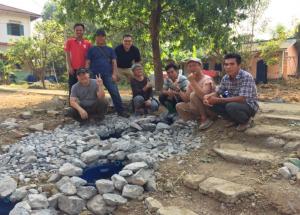 Veuk Chum presents his thinking, for Cambodia, based on the example of sustainable farming that he manages at the Peaceful Children's Home 2, in Battambang. 'Even though it is a small part of the solution to climate change, it could be a role model or a pilot project for rural household farmers. And I hope that it could an important piece to complete the big puzzle.”
Veuk Chum presents his thinking, for Cambodia, based on the example of sustainable farming that he manages at the Peaceful Children's Home 2, in Battambang. 'Even though it is a small part of the solution to climate change, it could be a role model or a pilot project for rural household farmers. And I hope that it could an important piece to complete the big puzzle.”
' I am not a farmer by training but by compassion, inspired by the Bocock family, who were passionate about helping other farmers in poor countries across the world,”he says.
The impacts of climate change on farmers in the case of Cambodia:
Impacts of Climate Change
Cambodia is one of the most affected countries in Southeast Asia, with limited resources and with little preparedness, weak adaptive capacity. Experts warn that climate change could cause more droughts or floods for Cambodia. Cambodian's main agricultural activities depend on agriculture for food such as farming, forestry, and fisheries are heavily dependent on rainfall, making it very vulnerable to the impacts of climate change, particularly the rural household's farmers (women and other vulnerable groups).
The latest climate change impacts: flood (42%), drought (15%), fire (17%), storm (14%), lightning (7%) and pest outbreak (1%). The disasters killed 2,050 people. Floods accounted for 53% of the total number lost. (The Cambodia Disaster Loss and Damage Analysis Report)
The 2050 climate projections would affect around 7 million Cambodians employed in the agricultural sector and about 240,000 in construction, causing a total economic impact of $1.5 billion (USAID Analysis).
For Cambodia, the options for adapting to climate change are few, and Cambodia has been seeking financial assistance for adaptation. And climate change mitigation from developed countries responsible for contributing to climate change. Adapters To the Swedish Community- Based Climate Change (CCBAP) and the Australian Government Aid (AusAID). The adaptation program aims at strengthening community capacity on climate change mitigation and adaptation. Donated $ 2.8 million Over 46 projects for 380 villages, 107 communes, 56 districts and 21 provinces.
Solutions
1. Agriculture:
- Climate change adaptation
- Development of high yielding crop species
- Improved crop management: crop rotation, grow variety of plants
- Establish an early warning system: for extreme weather events and improve irrigation
- Conservation tillage
- Pasture-based livestock husbandry
2. Forestry:
- Increasing forest plantations
- Conserving protected areas
- Improving forest management
3. Environment preservation
- Non toxic
- No chemical fertilizer: pesticides
- No genetically modified seeds
4. Reduce of Carbon dioxides
- Use solar energy
- Cut down the burning fossil fuel
- Measuring the Carbon footprint
- Control of human and industrial activities
An example of sustainable gardening (farming) activities at the Peaceful Children's Home 2, in Battambang province:
Wastewater management system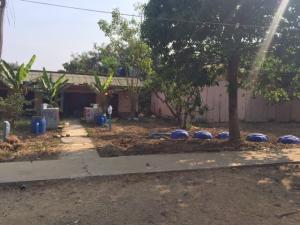
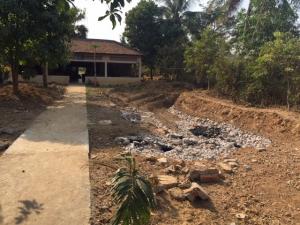
The wastewater filtration system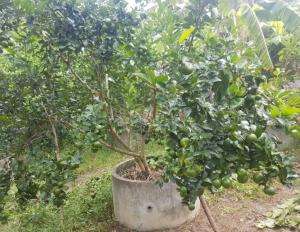 The wastewater from shower room, washing stations will go through these tanks, tanks are filled with rocks (big and small). The filtered water will go to the pond (second picture), usable water for plantation but it is not drinkable. In the pond fish will be raised, water plants will be grown etc. Below pictures is the barrels of Enzime processing, put waste from kitchen: vegetables, fruits. The finished enzime will be used and put into the filtering barrels in order to kill the smell of the wastewater. The residues from the enzime will be used to make a compost fertilizer.
The wastewater from shower room, washing stations will go through these tanks, tanks are filled with rocks (big and small). The filtered water will go to the pond (second picture), usable water for plantation but it is not drinkable. In the pond fish will be raised, water plants will be grown etc. Below pictures is the barrels of Enzime processing, put waste from kitchen: vegetables, fruits. The finished enzime will be used and put into the filtering barrels in order to kill the smell of the wastewater. The residues from the enzime will be used to make a compost fertilizer.
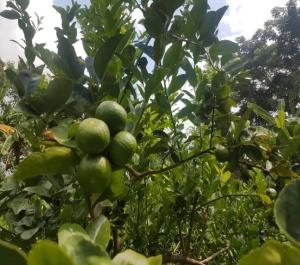 The compost fertilizer is used to plant the fruit trees and vegetables. The lime trees are planted in the cement rings, in order to easily control the water usage, the weeds and grasses. No pesticides needed!
The compost fertilizer is used to plant the fruit trees and vegetables. The lime trees are planted in the cement rings, in order to easily control the water usage, the weeds and grasses. No pesticides needed!



